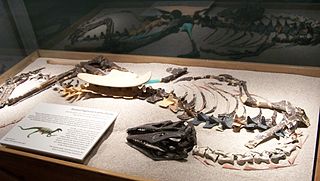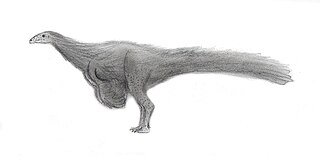
Coeluridae is a historically unnatural group of generally small, carnivorous dinosaurs from the late Jurassic Period. For many years, any small Jurassic or Cretaceous theropod that did not belong to one of the more specialized families recognized at the time was classified with the coelurids, creating a confusing array of 'coelurid' theropods that were not closely related. Although they have been traditionally included in this family, there is no evidence that any of these primitive coelurosaurs form a natural group with Coelurus, the namesake of Coeluridae, to the exclusion of other traditional coelurosaur groups.

Coelurosauria is the clade containing all theropod dinosaurs more closely related to birds than to carnosaurs.

Therizinosaurs are an extinct group of large herbivorous theropod dinosaurs whose fossils have been found across the Middle Jurassic to Late Cretaceous deposits in Europe, Asia and North America. Various features of the forelimbs, skull and pelvis unite these finds as both theropods and maniraptorans, making them relatives of birds. The name of the representative genus, Therizinosaurus, is derived from the Greek θερίζω and σαῦρος. The older representative, Segnosaurus, is derived from the Latin sēgnis ('slow') and the Greek σαῦρος.
Coelurus is a genus of coelurosaurian dinosaur from the Late Jurassic period. The name means "hollow tail", referring to its hollow tail vertebrae. Although its name is linked to one of the main divisions of theropods (Coelurosauria), it has historically been poorly understood, and sometimes confused with its better-known contemporary Ornitholestes. Like many dinosaurs studied in the early years of paleontology, it has had a confusing taxonomic history, with several species being named and later transferred to other genera or abandoned. Only one species is currently recognized as valid: the type species, C. fragilis, described by Othniel Charles Marsh in 1879. It is known from one partial skeleton found in the Morrison Formation of Wyoming, United States. It was a small bipedal carnivore with elongate legs.

Proceratosaurus is a genus of carnivorous theropod dinosaur from the Middle Jurassic (Bathonian) of England. It contains a single species. P. bradleyi, known from a mostly complete skull and lower jaws. Proceratosaurus was a small dinosaur, estimated to measure around 3 m (9.8 ft) in length. Its name refers to how it was originally thought to be an ancestor of Ceratosaurus, due to the partially preserved portion of the crest of Proceratosaurus superficially resembling the small crest of Ceratosaurus. Now, however, it is considered a coelurosaur, specifically a member of the family Proceratosauridae, and amongst the earliest known members of the clade Tyrannosauroidea.
Phaedrolosaurus is a genus of theropod dinosaur, based on a single tooth possibly from the Valanginian-Albian-age Lower Cretaceous Lianmugin Formation of Wuerho, Xinjiang, China.
Tugulusaurus is a genus of coelurosaurian theropod dinosaur that belongs to the Alvarezsauroidea. It is known from the Early Cretaceous Tugulu Group in the Urhe area of the People's Republic of China. It was one of the first members of Alvarezsauria ever discovered.

Kelmayisaurus is an extinct genus of carcharodontosaurid theropod dinosaur from the Early Cretaceous. It was roughly 10–12 meters long and its name refers to the petroleum-producing city of Karamay in the Xinjiang province of western China near where it was found.

Nqwebasaurus is a basal coelurosaur and is the basal-most member of the coelurosaurian clade Ornithomimosauria from the Early Cretaceous of South Africa. The name Nqwebasaurus is derived from the Xhosa word Nqweba which is the local name for the Kirkwood district, and thwazi is ancient Xhosa for "fast runner". Currently it is the oldest coelurosaur in Africa and shows that basal coelurosaurian dinosaurs inhabited Gondwana 50 million years earlier than previously thought. The type specimen of Nqwebasaurus was discovered by William J. de Klerk who is affiliated with the Albany Museum in Grahamstown. It is the only fossil of its species found to date and was found in the Kirkwood Formation of the Uitenhage Group. Nqwebasaurus has the unofficial nickname "Kirky", due to being found in the Kirkwood.

A crurotarsal joint is one that’s situated between the bones of crus, i.e. shin and the proximal tarsal bones, i.e. astragalus and calcaneum.
The Shishugou Formation is a geological formation in Xinjiang, China.

Haplocheirus is an extinct genus of theropod dinosaur from the Middle Jurassic Shishugou Formation of Xinjiang in China. It is generally considered to be an alvarezsauroid, although some researchers have questioned this assignment. The genus contains a single species, H. sollers, which is known from a mostly complete skeleton including the skull.

Alvarezsauroidea is a group of small maniraptoran dinosaurs. Alvarezsauroidea, Alvarezsauridae, and Alvarezsauria are named for the historian Gregorio Álvarez, not the more familiar physicist Luis Alvarez, or his son geologist Walter Alvarez who jointly proposed that the Cretaceous–Paleogene extinction event was caused by an impact event. The group was first formally proposed by Choiniere and colleagues in 2010, to contain the family Alvarezsauridae and non-alvarezsaurid alvarezsauroids, such as Haplocheirus, which is the basalmost of the Alvarezsauroidea. The discovery of Haplocheirus extended the stratigraphic evidence for the group Alvarezsauroidea about 63 million years further in the past. The division of Alvarezsauroidea into the Alvarezsauridae and the non-alvarezsaurid alvarezsauroids is based on differences in their morphology, especially in their hand morphology.

Lagerpetidae is a family of basal avemetatarsalians. Though traditionally considered the earliest-diverging dinosauromorphs, fossils described in 2020 suggest that lagerpetids may instead be pterosauromorphs. Lagerpetid fossils are known from the Triassic of Argentina, Arizona, Brazil, Madagascar, New Mexico, and Texas. They were typically small, although some lagerpetids, like Dromomeron gigas and a specimen from the Santa Rosa Formation attributed to Dromomeron sp., were able to get quite large. Lagerpetid fossils are rare; the most common finds are bones of the hindlimbs, which possessed a number of unique features.

Zuolong is an extinct genus of tetanuran theropod from the Late Jurassic period of China. The type and only species is Z. salleei. The generic name of Zuolong is in honor of General Zu Zōngtáng with the Chinese word "long" which means dragon. The specific epithet "salleei" is in honor of Hilmar Sallee, who funded the expedition which led to the specimen's discovery.

Alnashetri is an extinct genus of alvarezsaurid coelurosaurian theropod dinosaur known from the early Late Cretaceous of La Buitrera, Río Negro Province, Argentina. It contains one known species, Alnashetri cerropoliciensis. Its remains were discovered in Candeleros Formation.

Aorun is a genus of carnivorous theropod dinosaur first discovered in 2006, with its scientific description published in 2013. It is one of the oldest known coelurosaurian dinosaurs and is estimated to have lived ~161.6 million years ago during the Late Jurassic Period. It is the fifth extinct theropod discovered from Wucaiwan, China.

Afromimus is a genus of theropod dinosaur from the Early Cretaceous Elrhaz Formation of Niger. It contains a single species, A. tenerensis, named in 2017 by Paul Sereno from parts of the right leg, vertebrae, and ribs found in the Ténéré Desert. It was originally classified as an ornithomimosaurian, but subsequently it was argued to be an abelisauroid.

Aratasaurus is a monotypic genus of basal coelurosaurian theropod which includes a single species, Aratasaurus museunacionali, known from fossils found in deposits of the Romualdo Formation in Brazil. Aratasaurus lived during the Albian stage of the Early Cretaceous.






























